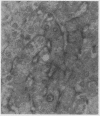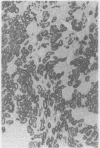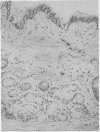Abstract
The monoclonal antibody AGF4.48 detects the 3-fucosyl-N-acetyllactosamine carbohydrate structure and reacts with a variety of human tissues, as shown by an immunoperoxidase method on paraffin sections of formalin fixed material. The intensity and distribution of the immunoperoxidase reactivity were affected by treatment of sections with neuraminidase. In some sites, such as bone marrow, brain, breast, and pituitary, the reaction was more intense after neuraminidase treatment. In several organs, including kidney, oesophagus, pancreas, submandibular gland, and uterus, the reaction was more widespread after neuraminidase treatment. Other organs, such as liver, lung, lymph node, skin, and uterine tube, showed an altered distribution of reactivity with AGF4.48 after sections were treated with neuraminidase. These results show that the 3-fucosyl-N-acetyllactosamine antigen is cryptic in many tissues. The antigen is masked to a variable extent in different tissues by neuraminic acid residues and can be revealed by the simple procedure of pretreating sections with neuraminidase. The value of using AGF4.48 antibody in combination with the enzyme neuraminidase to show accessible and cryptic antigen is that this reveals distinctive patterns of sialylation within various normal tissues. Whether similar patterns occur in disease will be of particular interest.
Full text
PDF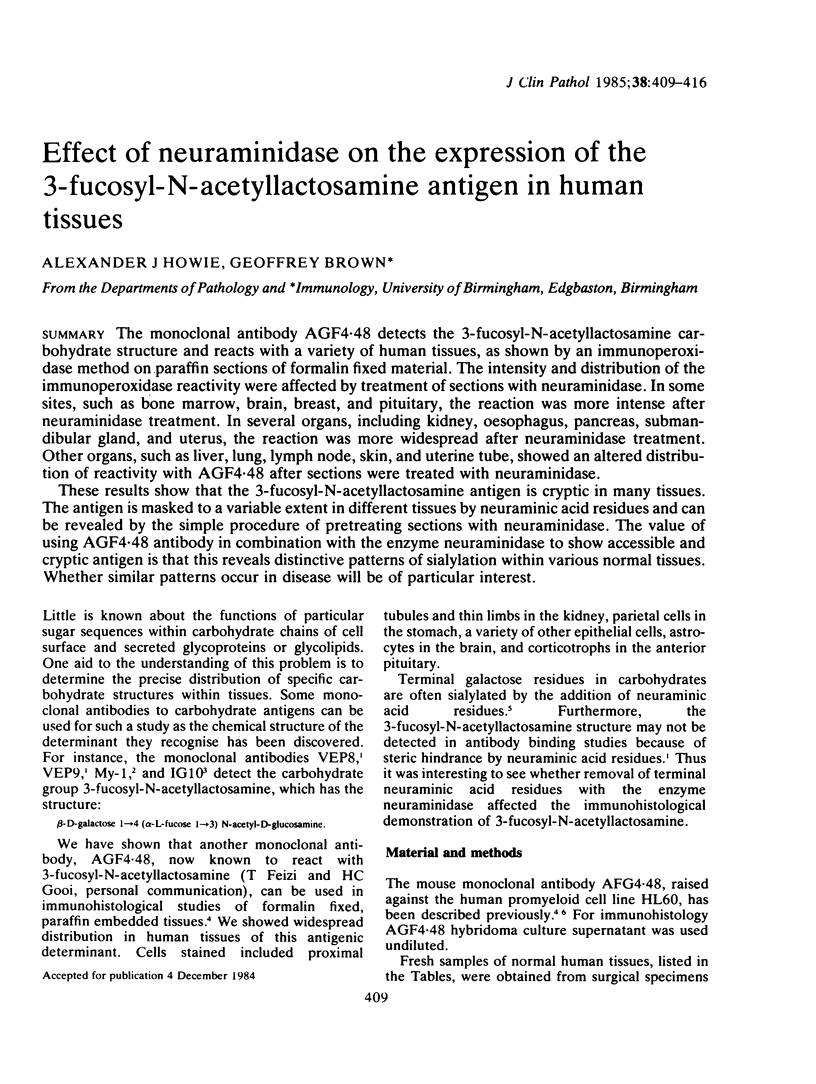

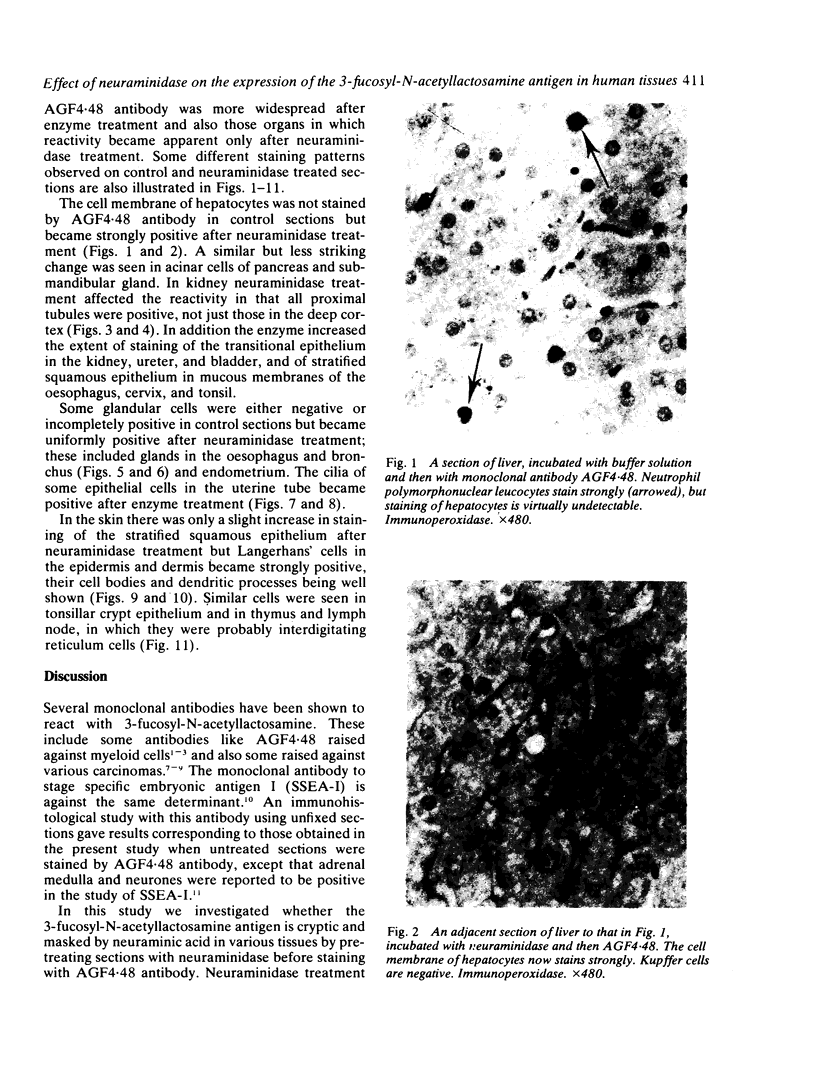

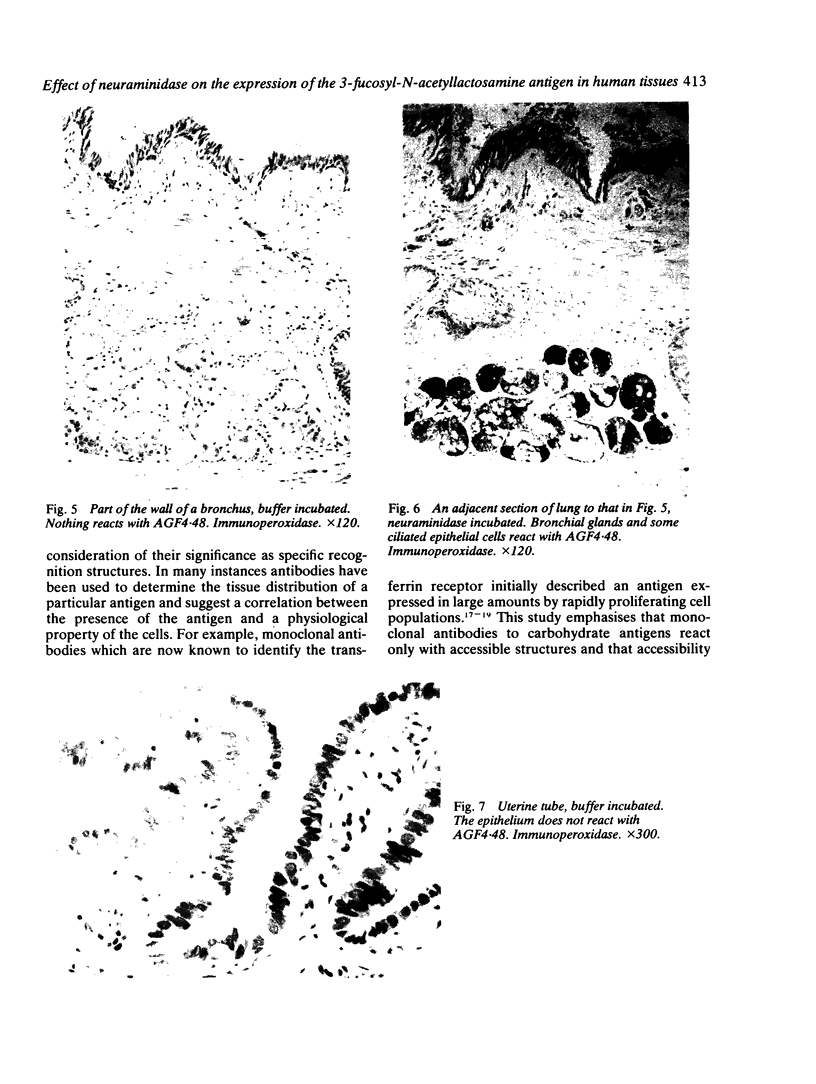
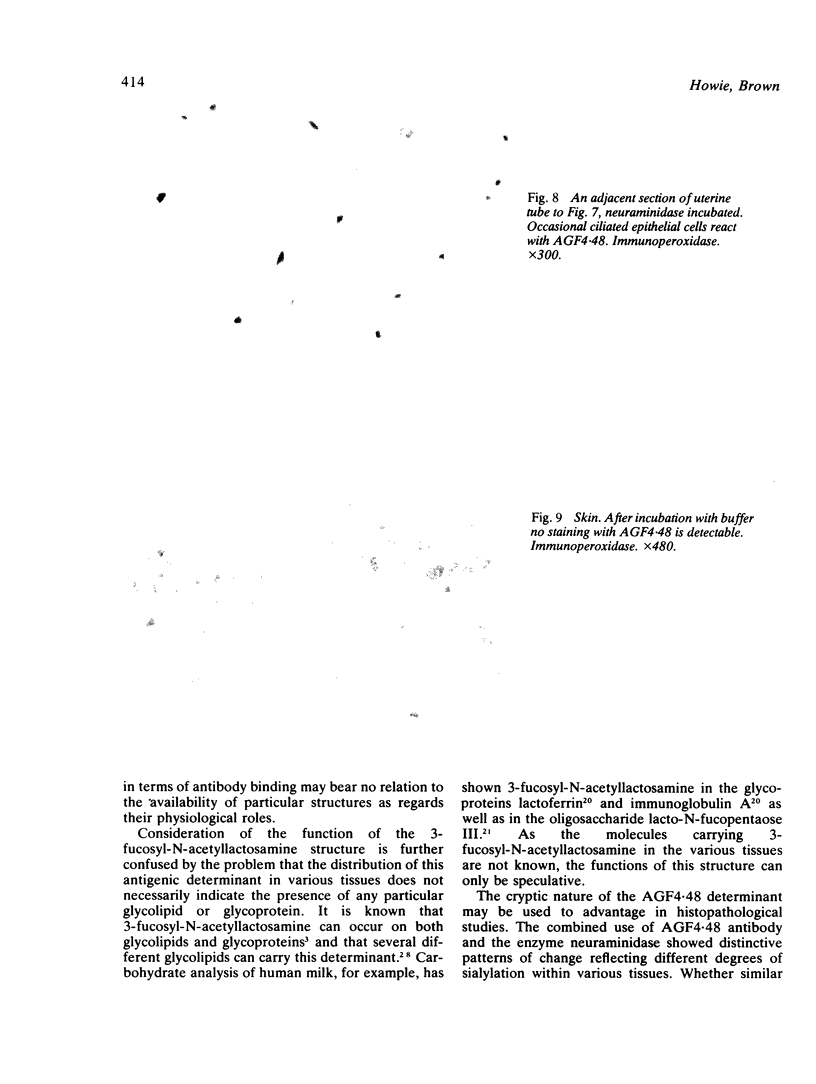
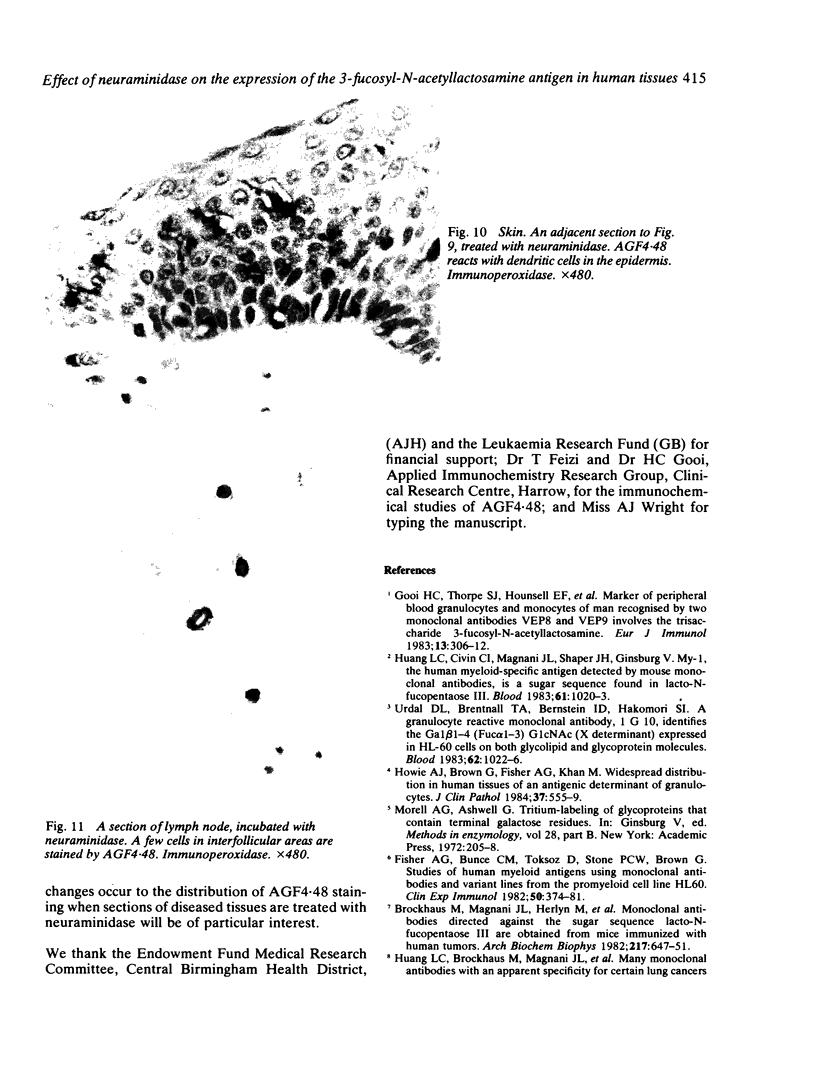

Images in this article
Selected References
These references are in PubMed. This may not be the complete list of references from this article.
- Ashall F., Bramwell M. E., Harris H. A new marker for human cancer cells. 1 The Ca antigen and the Ca1 antibody. Lancet. 1982 Jul 3;2(8288):1–6. doi: 10.1016/s0140-6736(82)91150-3. [DOI] [PubMed] [Google Scholar]
- Bramwell M. E., Bhavanandan V. P., Wiseman G., Harris H. Structure and function of the Ca antigen. Br J Cancer. 1983 Aug;48(2):177–183. doi: 10.1038/bjc.1983.173. [DOI] [PMC free article] [PubMed] [Google Scholar]
- Brockhaus M., Magnani J. L., Herlyn M., Blaszczyk M., Steplewski Z., Koprowski H., Ginsburg V. Monoclonal antibodies directed against the sugar sequence of lacto-N-fucopentaose III are obtained from mice immunized with human tumors. Arch Biochem Biophys. 1982 Sep;217(2):647–651. doi: 10.1016/0003-9861(82)90546-x. [DOI] [PubMed] [Google Scholar]
- Fisher A. G., Bunce C. M., Toksoz D., Stone P. C., Brown G. Studies of human myeloid antigens using monoclonal antibodies and variant lines from the promyeloid cell line HL60. Clin Exp Immunol. 1982 Nov;50(2):374–381. [PMC free article] [PubMed] [Google Scholar]
- Fox N., Damjanov I., Knowles B. B., Solter D. Immunohistochemical localization of the mouse stage-specific embryonic antigen 1 in human tissues and tumors. Cancer Res. 1983 Feb;43(2):669–678. [PubMed] [Google Scholar]
- Fukushi Y., Hakomori S., Nudelman E., Cochran N. Novel fucolipids accumulating in human adenocarcinoma. II. Selective isolation of hybridoma antibodies that differentially recognize mono-, di-, and trifucosylated type 2 chain. J Biol Chem. 1984 Apr 10;259(7):4681–4685. [PubMed] [Google Scholar]
- Gooi H. C., Feizi T., Kapadia A., Knowles B. B., Solter D., Evans M. J. Stage-specific embryonic antigen involves alpha 1 goes to 3 fucosylated type 2 blood group chains. Nature. 1981 Jul 9;292(5819):156–158. doi: 10.1038/292156a0. [DOI] [PubMed] [Google Scholar]
- Gooi H. C., Thorpe S. J., Hounsell E. F., Rumpold H., Kraft D., Förster O., Feizi T. Marker of peripheral blood granulocytes and monocytes of man recognized by two monoclonal antibodies VEP8 and VEP9 involves the trisaccharide 3-fucosyl-N-acetyllactosamine. Eur J Immunol. 1983 Apr;13(4):306–312. doi: 10.1002/eji.1830130407. [DOI] [PubMed] [Google Scholar]
- Howie A. J., Brown G., Fisher A. G., Khan M. Widespread distribution in human tissues of an antigenic determinant of granulocytes. J Clin Pathol. 1984 May;37(5):555–559. doi: 10.1136/jcp.37.5.555. [DOI] [PMC free article] [PubMed] [Google Scholar]
- Huang L. C., Brockhaus M., Magnani J. L., Cuttitta F., Rosen S., Minna J. D., Ginsburg V. Many monoclonal antibodies with an apparent specificity for certain lung cancers are directed against a sugar sequence found in lacto-N-fucopentaose III. Arch Biochem Biophys. 1983 Jan;220(1):318–320. doi: 10.1016/0003-9861(83)90417-4. [DOI] [PubMed] [Google Scholar]
- Huang L. C., Civin C. I., Magnani J. L., Shaper J. H., Ginsburg V. My-1, the human myeloid-specific antigen detected by mouse monoclonal antibodies, is a sugar sequence found in lacto-N-fucopentaose III. Blood. 1983 May;61(5):1020–1023. [PubMed] [Google Scholar]
- Kobata A., Ginsburg V. Oligosaccharides of human milk. II. Isolation and characterization of a new pentasaccharide, lacto-N-fucopentaose 3. J Biol Chem. 1969 Oct 25;244(20):5496–5502. [PubMed] [Google Scholar]
- Magnani J. L., Nilsson B., Brockhaus M., Zopf D., Steplewski Z., Koprowski H., Ginsburg V. A monoclonal antibody-defined antigen associated with gastrointestinal cancer is a ganglioside containing sialylated lacto-N-fucopentaose II. J Biol Chem. 1982 Dec 10;257(23):14365–14369. [PubMed] [Google Scholar]
- Nudelman E., Hakomori S., Kannagi R., Levery S., Yeh M. Y., Hellström K. E., Hellström I. Characterization of a human melanoma-associated ganglioside antigen defined by a monoclonal antibody, 4.2. J Biol Chem. 1982 Nov 10;257(21):12752–12756. [PubMed] [Google Scholar]
- Rauvala H. The fucoganglioside of human kidney. FEBS Lett. 1976 Feb 15;62(2):161–164. doi: 10.1016/0014-5793(76)80043-9. [DOI] [PubMed] [Google Scholar]
- Sutherland R., Delia D., Schneider C., Newman R., Kemshead J., Greaves M. Ubiquitous cell-surface glycoprotein on tumor cells is proliferation-associated receptor for transferrin. Proc Natl Acad Sci U S A. 1981 Jul;78(7):4515–4519. doi: 10.1073/pnas.78.7.4515. [DOI] [PMC free article] [PubMed] [Google Scholar]
- Trowbridge I. S., Omary M. B. Human cell surface glycoprotein related to cell proliferation is the receptor for transferrin. Proc Natl Acad Sci U S A. 1981 May;78(5):3039–3043. doi: 10.1073/pnas.78.5.3039. [DOI] [PMC free article] [PubMed] [Google Scholar]
- Urdal D. L., Brentnall T. A., Bernstein I. D., Hakomori S. I. A granulocyte reactive monoclonal antibody, 1G10, identifies the Gal beta 1-4 (Fuc alpha 1-3)GlcNAc (X determinant) expressed in HL-60 cells on both glycolipid and glycoprotein molecules. Blood. 1983 Nov;62(5):1022–1026. [PubMed] [Google Scholar]




